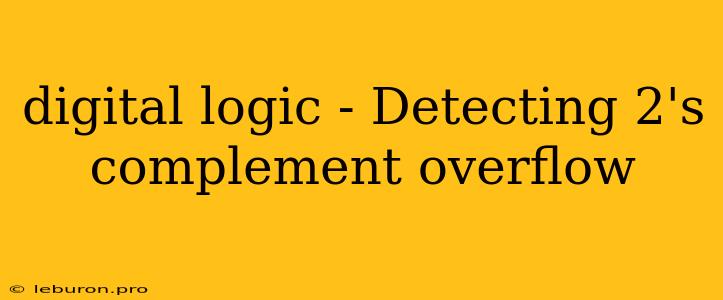In the realm of digital circuits and computer arithmetic, understanding digital logic is paramount. One crucial aspect involves handling signed numbers, particularly when performing arithmetic operations. A common technique used to represent signed numbers is the 2's complement representation. While it's a powerful and efficient method, it's essential to be aware of a potential issue: overflow. This article delves into the intricacies of detecting 2's complement overflow in digital logic, exploring the underlying principles and practical approaches.
Understanding 2's Complement Representation
Before diving into overflow detection, let's establish a firm grasp of 2's complement representation. In this system, the most significant bit (MSB) serves as the sign bit: 0 for positive numbers and 1 for negative numbers. To obtain the 2's complement of a negative number, we invert all the bits and add 1. This representation facilitates straightforward addition and subtraction operations, regardless of the signs of the operands.
For instance, consider a 4-bit system. The decimal number 5 is represented as 0101 in binary. To find the 2's complement of -5, we invert the bits (1010) and add 1, resulting in 1011. This representation seamlessly integrates with addition. Adding 5 and -5 using 2's complement yields 0000 (carrying over the MSB).
The Challenge of Overflow
While 2's complement representation simplifies arithmetic operations, it introduces a potential issue: overflow. Overflow occurs when the result of an arithmetic operation exceeds the capacity of the representation system. In a fixed-width system (like a 4-bit system), we have a limited range of values we can represent. Overflow can lead to inaccurate results, corrupting calculations.
Consider an example: adding 7 (0111) and 5 (0101) in a 4-bit system. The expected sum is 12, but in binary, it would be 1100. However, with a 4-bit system, we can only represent values from -8 to 7. The MSB (1) indicates a negative value, leading to an incorrect result. This is a classic case of 2's complement overflow.
Detecting Overflow in 2's Complement
Fortunately, detecting 2's complement overflow is achievable with a few strategies:
1. Sign Bit Analysis
One simple method involves analyzing the sign bits of the operands and the result. If the operands have the same sign and the result has a different sign, overflow has occurred.
For example, adding two positive numbers should produce a positive result. If the result is negative, it indicates an overflow condition. Similarly, adding two negative numbers should yield a negative result. If the result is positive, overflow has taken place.
2. Carry-Out and Carry-In Analysis
Another approach involves examining the carry-in and carry-out signals of the most significant bit. If the carry-in and carry-out bits are different, overflow has occurred. This method leverages the fact that in 2's complement arithmetic, the carry-out bit serves as an indicator of overflow.
3. Overflow Flag in Arithmetic Logic Units (ALUs)
Many modern processors incorporate ALUs that include an overflow flag. This flag is set when overflow occurs during arithmetic operations, allowing the processor to identify and handle these situations.
Implementing Overflow Detection in Digital Logic
Let's delve into implementing overflow detection using logic gates. We'll demonstrate this with a 4-bit adder circuit:
A3 A2 A1 A0
B3 B2 B1 B0
----------------
S3 S2 S1 S0 Overflow
To detect overflow, we'll use XOR gates:
Overflow = (A3 XOR B3) XOR S3
This logic works because if the sign bits of the operands (A3 and B3) are the same, and the sign bit of the sum (S3) is different, overflow has occurred.
Practical Implications of Overflow Detection
The ability to detect 2's complement overflow is crucial in various digital systems:
- Microprocessors and microcontrollers: Processors need to identify overflow conditions to prevent incorrect calculations and maintain the integrity of program execution.
- Digital signal processing (DSP): DSP algorithms often involve extensive arithmetic operations. Overflow detection ensures accurate signal processing and prevents distortion.
- Error detection and correction: Detecting overflow can help identify potential errors in data transmission or storage.
Conclusion
2's complement overflow is a potential issue in digital logic, but understanding its causes and implementing appropriate detection mechanisms is essential for building reliable and efficient digital systems. By carefully analyzing sign bits, carry signals, or using dedicated overflow flags, we can effectively mitigate the risks of 2's complement overflow.
